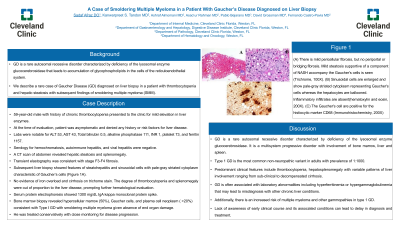Back


Poster Session C - Monday Afternoon
Category: Liver
C0598 - A Case of Smoldering Multiple Myeloma in a Patient With Gaucher’s Disease Diagnosed on Liver Biopsy
Monday, October 24, 2022
3:00 PM – 5:00 PM ET
Location: Crown Ballroom

Has Audio

Sadaf Afraz, DO
Cleveland Clinic Florida
Weston, Florida
Presenting Author(s)
Sadaf Afraz, DO1, Kanwarpreet Tandon, MD1, Ashraf Almomani, MD2, Adalberto Gonzalez, MD1, Asad ur Rahman, MD1, Pablo Bejarano, MD1, David Grossman, MD1, Fernando Castro-Pavia, MD1
1Cleveland Clinic Florida, Weston, FL; 2Cleveland Clinic Foundation, Cleveland, OH
Introduction: We describe a rare case of Gaucher Disease (GD) diagnosed on liver biopsy in a patient with thrombocytopenia and hepatic steatosis with subsequent findings of smoldering multiple myeloma (SMM).
Case Description/Methods: 59-year-old male with history of chronic thrombocytopenia presented to the clinic for mild elevation in liver enzymes. At the time of evaluation, patient was asymptomatic and denied any history or risk factors for liver disease. Labs were notable for ALT 53, AST 43, Total bilirubin 0.5, alkaline phosphatase 111, INR 1, platelet 73, and ferritin 1157. Serology for hemochromatosis, autoimmune hepatitis, and viral hepatitis were negative. A CT scan of abdomen revealed hepatic steatosis and splenomegaly. Transient elastography was consistent with stage F3-F4 fibrosis. Subsequent liver biopsy showed features of steatohepatitis and sinusoidal cells with pale-gray striated cytoplasm characteristic of Gaucher’s cells. No evidence of iron overload and cirrhosis on trichome stain. The degree of thrombocytopenia and splenomegaly were out of proportion to the liver disease, prompting further hematological evaluation. Serum protein electrophoresis showed 1300 mg/dL IgA kappa monoclonal protein spike. Bone marrow biopsy revealed hypercellular marrow (50%), Gaucher cells, and plasma cell neoplasm ( >20%) consistent with Type I GD with smoldering multiple myeloma given absence of end organ damage. He was treated conservatively with close monitoring for disease progression.
Discussion: GD is a rare autosomal recessive disorder characterized by deficiency of the lysosomal enzyme glucocerebrosidase that leads to accumulation of glycophospholipids in the cells of the reticuloendothelial system. It is a multisystem progressive disorder with involvement of bone marrow, liver and spleen. Type 1 GD is the most common non-neuropathic variant in adults with prevalence of 1:1000. Predominant clinical features include thrombocytopenia, hepatosplenomegaly with variable patterns of liver involvement ranging from sub-clinical to decompensated cirrhosis. GD is often associated with laboratory abnormalities including hyperferritinemia or hypergammaglobulinemia that may lead to misdiagnosis with other chronic liver conditions. Additionally, there is an increased risk of multiple myeloma and other gammopathies in type 1 GD. Lack of awareness of early clinical course and its associated conditions can lead to delay in diagnosis and treatment.

Disclosures:
Sadaf Afraz, DO1, Kanwarpreet Tandon, MD1, Ashraf Almomani, MD2, Adalberto Gonzalez, MD1, Asad ur Rahman, MD1, Pablo Bejarano, MD1, David Grossman, MD1, Fernando Castro-Pavia, MD1. C0598 - A Case of Smoldering Multiple Myeloma in a Patient With Gaucher’s Disease Diagnosed on Liver Biopsy, ACG 2022 Annual Scientific Meeting Abstracts. Charlotte, NC: American College of Gastroenterology.
1Cleveland Clinic Florida, Weston, FL; 2Cleveland Clinic Foundation, Cleveland, OH
Introduction: We describe a rare case of Gaucher Disease (GD) diagnosed on liver biopsy in a patient with thrombocytopenia and hepatic steatosis with subsequent findings of smoldering multiple myeloma (SMM).
Case Description/Methods: 59-year-old male with history of chronic thrombocytopenia presented to the clinic for mild elevation in liver enzymes. At the time of evaluation, patient was asymptomatic and denied any history or risk factors for liver disease. Labs were notable for ALT 53, AST 43, Total bilirubin 0.5, alkaline phosphatase 111, INR 1, platelet 73, and ferritin 1157. Serology for hemochromatosis, autoimmune hepatitis, and viral hepatitis were negative. A CT scan of abdomen revealed hepatic steatosis and splenomegaly. Transient elastography was consistent with stage F3-F4 fibrosis. Subsequent liver biopsy showed features of steatohepatitis and sinusoidal cells with pale-gray striated cytoplasm characteristic of Gaucher’s cells. No evidence of iron overload and cirrhosis on trichome stain. The degree of thrombocytopenia and splenomegaly were out of proportion to the liver disease, prompting further hematological evaluation. Serum protein electrophoresis showed 1300 mg/dL IgA kappa monoclonal protein spike. Bone marrow biopsy revealed hypercellular marrow (50%), Gaucher cells, and plasma cell neoplasm ( >20%) consistent with Type I GD with smoldering multiple myeloma given absence of end organ damage. He was treated conservatively with close monitoring for disease progression.
Discussion: GD is a rare autosomal recessive disorder characterized by deficiency of the lysosomal enzyme glucocerebrosidase that leads to accumulation of glycophospholipids in the cells of the reticuloendothelial system. It is a multisystem progressive disorder with involvement of bone marrow, liver and spleen. Type 1 GD is the most common non-neuropathic variant in adults with prevalence of 1:1000. Predominant clinical features include thrombocytopenia, hepatosplenomegaly with variable patterns of liver involvement ranging from sub-clinical to decompensated cirrhosis. GD is often associated with laboratory abnormalities including hyperferritinemia or hypergammaglobulinemia that may lead to misdiagnosis with other chronic liver conditions. Additionally, there is an increased risk of multiple myeloma and other gammopathies in type 1 GD. Lack of awareness of early clinical course and its associated conditions can lead to delay in diagnosis and treatment.

Figure: Image 1: (A) There is mild pericellular fibrosis, but no periportal or bridging fibrosis. Mild steatosis supportive of a component of NASH accompany the Gaucher's cells is seen (Trichrome, 100X). (B) Sinusoidal cells are enlarged and show pale-gray striated cytoplasm representing Gaucher's cells whereas the hepatocytes are ballooned. Inflammatory infiltrates are absent(hematoxylin and eosin, 200X). (C) The Gaucher's cell are positive for the histiocytic marker CD68 (Immunohistochemistry, 200X)
Disclosures:
Sadaf Afraz indicated no relevant financial relationships.
Kanwarpreet Tandon indicated no relevant financial relationships.
Ashraf Almomani indicated no relevant financial relationships.
Adalberto Gonzalez indicated no relevant financial relationships.
Asad ur Rahman indicated no relevant financial relationships.
Pablo Bejarano indicated no relevant financial relationships.
David Grossman indicated no relevant financial relationships.
David Grossman — NO DISCLOSURE DATA.
Fernando Castro-Pavia indicated no relevant financial relationships.
Sadaf Afraz, DO1, Kanwarpreet Tandon, MD1, Ashraf Almomani, MD2, Adalberto Gonzalez, MD1, Asad ur Rahman, MD1, Pablo Bejarano, MD1, David Grossman, MD1, Fernando Castro-Pavia, MD1. C0598 - A Case of Smoldering Multiple Myeloma in a Patient With Gaucher’s Disease Diagnosed on Liver Biopsy, ACG 2022 Annual Scientific Meeting Abstracts. Charlotte, NC: American College of Gastroenterology.
